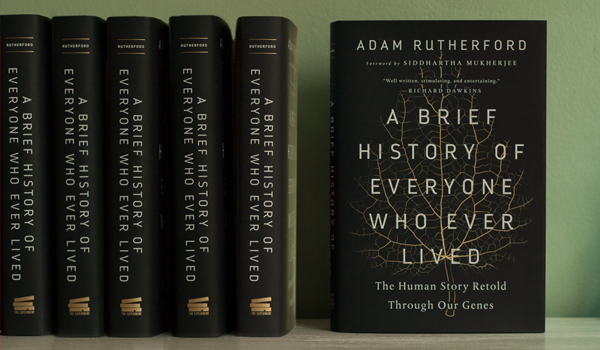By Adam Rutherford, author of A Brief History of Everyone Who Ever Lived: The Human Story Retold Through Our Genes, published by The Experiment. This essay originally ran on Salon.com.
Buy the Book
Amazon | B&N | Indiebound | Workman

Evolution deceives our eyes. We are a species that relies heavily on our vision, and we use what we see to observe and make assumptions about other people. The crudeness of racial categorization relies almost entirely on skin color, and perhaps a handful of other physical characteristics, such as hair texture.
But our eyes provide an extremely limited view of reality. There is sense to the phrase “skin deep” when we speak of race. It is metaphorically correct in the sense that there is only one human species remaining (of at least five that existed alongside us in the last 100,000 years) and that we are all desperately closely related—we need only to go back to the 14th century BCE to arrive at an era when all humans alive were the ancestors of all humans alive today.
“Skin deep” is also a useful phrase when thinking about the genetics that underly human variation. Only a handful of genes out of 20,000 influence all the skin tones available to human beings. The most comprehensive study of the genes involved in pigmentation was published last week, led by Sarah Tishkoff from the University of Pennsylvania. Modern techniques in genomics have made it easier and easier to sample huge proportions of our genetic code in thousands of people. Tishkoff and her team did exactly that on the hunt for genes that influence skin pigmentation. They looked at the DNA of more than 1500 living people from 10 different ethnic groups in Botswana, Tanzania and Ethiopia. They found eight genes that account for 29 percent of the variation they observed in skin tones (if that doesn’t seem like much, in these sorts of studies, 29 percent is in fact huge; much of the rest of the variation will be accounted for in many far less common—and therefore more difficult to detect—genes).
The genes themselves are mostly unsurprising. We’ve known about those elements of DNA involved in skin color for a few years now, but primarily in relation to lighter skin and Europeans. The variation in the African samples is definitely surprising. Studies from only a couple of years ago showed that hunter gatherer populations in Europe had dark skin 8000 years ago, but that light skinned (and blue-eyed) variants of several genes were found in the remains of 7700 year-old bodies found in Sweden. Pale skin is associated with living in cooler, less sunny climates, where the body’s efficiency in producing vitamin D is impeded —the closer your evolution occurred to the equator, the more likely you are to have darker skin. Tishkoff’s survey of African genomes revealed a much more complex story. They saw genetic variants for lighter colored skin in both Europeans and in the San hunter-gatherers in Botswana. The origin of that DNA appears to be a very ancient 900,000 years ago, meaning that it predates even the oldest inception of Homo sapiens—us —by more than half a million years. They saw versions of both in the Neanderthals, from whom we split some 600,000 years ago (but rekindled our sexual relationships in Europe around 40,000 years ago). They suggest that Neanderthals probably also had a mix of different skin color genes and that some were dark skinned and some were pale. The new paper also suggests that some genetic variants in South Asia may have been inherited from African people, and similarly, some pale skinned genes also may well have originated in Africa.
This story is perfectly emblematic of the new story of our own evolution that was once simple and straightforward, but is becoming increasingly, beautifully complicated. It shows that skin color is a fascinating area of science, about which we are only scratching the surface. As is becoming ever more clear today, it reveals that human variation is complex, non-linear, messy, and that we have a long way still to go to understand even the most superficial of human traits.
What it also implies is that skin color and a scientific idea of race are not easy bedfellows. Sarah Tishkoff told The New York Times that this “dispels a biological concept of race.” When we speak of race, we talk about “black,” roughly meaning dark skinned people of relatively recent African ancestry. What genetics says is that this is meaningless in scientific terms of categorizing people, and the new skin study reinforces that robustly. The variation in genes for pigmentation, even within Africa, yet again reveals a picture of genetic diversity within Africa that is wide, varied, rich and deep.
We’ve known for many years that genetics has profoundly undermined the concept of race. At least, there is very little correlation between variation between people’s DNA, and variation in the traits that are traditionally associated with how we talk about race. We casually talk about black people, or East Asians, or South Asians without any acknowledgement that these categories are crude to the point of being scientifically absurd. While it is true that the further you go east from Europe, the more likely people will have thicker straighter hair, a lower density of sweat glands, dryer, flakier earwax, and darker skin. There is also the epicanthic fold—the veil of skin that results in a distinctive eye shape that is largely absent in the rest of the world. But it is present in many other populations of non-East Asian descent including Berbers, Inuit, Scandinavians, Poles and many indigenous American populations. Furthermore, there are visible differences in epicanthic fold shape between the different people of Southeast Asia, to the extent that many people can distinguish between Koreans, Chinese, Japanese, and so on, solely on this basis.
The point is that humans are continuous in their variation. This is not to deny visible physical differences—that would be absurd and intellectually dishonest. It is merely pointing out that the physical traits we broadly use to colloquially talk of race are imprecise, clunky and not representative of overall diversity in humans by any measure.
Africa is not a huge homogenous continent populated by one people. That is obviously physically true, and overwhelmingly so when we look at DNA. There is more genetic variation within Africa than in the rest of the world put together. What this means is that if you were to take two Africans, say, a San tribe member and someone from the Ethiopian highlands, they will on average be more different from each other than either one is to anyone else on earth outside of Africa. Tishkoff found enormous variation, not just in the genes, but simply in the skin tones of the people she studied, even groups that are geographically close to one another. The true variation we see in humans within and outside Africa is largely to do with two things at which humans excel: sex and migration.
A few humans did migrate out of Africa some 100,000 years ago, and from that pool the rest of the world was largely founded. But this is not migration as we think of today. It happened over tens of thousands of years, and not in one straight line, as the maps sometimes suggest: we started here and ended up there. In truth, we followed seasons and food and hunts and climates, inching our way over thousands of years.
Humans are very bad at thinking in the long term. We have a great tendency to identify with our immediate kin in both time and space. We have nationalities and passports. Within that, we have towns and cities and roots and origin stories. My father is from the northeast of England, and I am firmly British. My mother is Indian, though Guyanese Indian, meaning that she has never set foot in India. But I have no real Indian identity beyond a love of curry and cricket. In fact, I identify much more closely with the Catholic culture of my stepmother who raised me (though, it has turned out that her grandfather was not the Joseph Adams we had thought, but was in fact naturalized as British from the Russian Orthodox Jewish name Josef Abrahams; how causally heritage is lost). In only three generations of my own trivial family history, migration, cultural identity is muddled like old wires in a drawer.
Times are changing when it comes to cultural identify and its relationship to DNA. Our genomes have become easily available to us via consumer genetic testing, with companies such as 23andMe and AncestryDNA. Millions of people have spat in a tube, paid a hundred bucks or so, and received a breakdown of where their DNA is most commonly found on Earth today. In my opinion it’s fun, but of trivial scientific value, and mine is entirely predictable: half is most commonly found in India, the other half in northern Europe. Genealogy is now the number one hobby in the U.S., as befits a nation whose population mostly immigrated to the Americas fewer than five centuries ago.
Yet the idea that DNA can reinforce a cultural identity is profoundly misplaced. For most people, the interest is sincere and recognizes the triviality of discovering you have Viking ancestry (save yourself your hard earned dough: everyone in Europe does). But more and more these days, racists and neo-Nazis are turning to consumer genetics to attempt to prove their racial purity and superiority. They fail, and will always fail, because no one is pure anything. Humans move, and humans reproduce. Anyone who claims a lineage back through history that entitles them to assert superiority has misunderstood how genealogy and genetic works. In these dark times, we look to shards of light, and sometimes I haunt neo-Nazi websites to see conversations play out when people discover that they have recent non-European DNA in their genomes.
We have come full circle in the short life of this science. Scientific racism is at the very base of the study of human variation, and indeed the root of human genetics. The whole field was founded by Francis Galton, a London gentleman of wealth and privilege, and, in my opinion, a brilliant inspired scientist nestling in on that all-too-overused category of ‘genius.’ Galton was a polymath, who invented statistical techniques we still use today; he helped found the use of fingerprints in forensics, published the first weather map, laid the groundwork for studying synesthesia, invented a vented hat to cool the brain whilst thinking hard, and designed a new system for cutting round cakes. Crucially though, he coveted data and created new methods to measure humans in many different ways. He effectively invented biometrics. He gave us the phrases ‘nature versus nurture’ to describe the interaction between our biological imperatives and the influence of our environment (though nowadays, ‘nature via nurture’ might be a better phrase, as these two things are not in conflict but in concert).
Galton was also a grotesque racist. He returned from travels as a young man in the heart of Africa convinced that there was a natural hierarchy to human races, with white British men at the very top. The Chinese followed, though he noted that while they were of superior intellect, they were prone to deceitfulness, unoriginality and an acquiescence to authority. The “Negro,” as was his contemporary parlance, was at the bottom of the pile and deserve to be colonized in Africa by the Chinese, as
“. . . average negroes possess too little intellect, self-reliance, and self-control to make it possible for them to sustain the burden of any respectable form of civilization without a large measure of external guidance and support.”
In the annals of Galton, there are plenty of similarly breathtaking thoughts. It is important not to judge people from history by contemporary mores, but even by the standards of Victorian England, Galton was strikingly racist, and arguably not typically so. Galton’s (half-)cousin was Charles Darwin, the greatest of all scientific minds, whose work he greatly admired. Darwin was demonstrably not a racist, though some of the language he used is still discomforting to our 21st century ears (his wife Emma’s affectionate nickname for him was “Nigger”). He was friends with and influenced by the freed black slave John Edmonstone during his undergraduate days in Edinburgh and was an abolitionist. Nevertheless, Galton was keen to establish a science that would demonstrate the natural order of men. (He wrote little about women, apart from an infamous study of female beauty across the British Isles in which he adjudged the most attractive women to reside in southwest London and the least in Aberdeen in Scotland; the data recording was done in secret, with a special contraption of his own design whereby he could mark observed women without detection; it was kept in his pocket and he called it a “pricker.”)
I digress. Galton birthed a science that encompasses all humankind. He founded a lab at University College London, which was retitled the “The Francis Galton Laboratory for National Eugenics.” That word, eugenics, was also of Galton’s coinage, but did not carry the toxic meaning that it does today. After the horrors of World War II, eugenics and racism were forever linked, and the lab’s name was changed to simply, “The Galton.” By the time I studied there in the 1990s, his legacy was beginning to reach its ironic conclusion, which is carried in Sarah Tishkoff’s latest study: the science that Galton founded in order to demonstrate racial hierarchies had done precisely the opposite.





No Comments